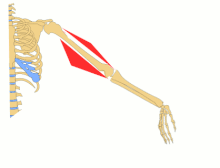Nursing Study Guide/Care of Musculoskeletal Needs

Principles of Biomechanics
[edit | edit source]Biomechanics is a science of movement of a human body including our muscles, bones, tendons and ligaments work together to produce movement. There are six principles.
1. The lower the center of gravity the larger the base of support - stability 2.maximum effort- production of maximum force requires the use of joints in order to perform largest to smallest 3. Linear motion- the greater the applied impulse the greater the increase in velocity 4. movement usually occurs in the direction opposite to that of the implied force 5. angular motion- is produced by the application of force acting at some distance from an axis 6. angular momentum is constant when a person or object is free in the air
Fractures
[edit | edit source]A fracture is a broken bone, often with a nearby soft tissue, blood vessel, and nerve damage, and is most commonly caused by injury to the bone. Some of the problems associated with bone fractures includes blood loss, injury to organs, tissues, or surrounding structures, and possibly stunted growth in children. Fracture types include:
- closed fractures
- open fractures
- comminuted fractures
fall prevention
[edit | edit source]Falls are a cause of fractures and associated mortality in aged clients. Interventions to target fall prevention should manage multiple risk factors [1]
treatment
[edit | edit source]Treatment is to set a broken bone. Fixation depends on the location and the severity of the injury. Partial or slight fractures are often treated conservatively. Bones such as the collarbone or toes, are immobilized with a sling or splint until healed.
First Aid for fractures is all about immobilizing the injury. Splints can be purpose-made or makeshift but will be effective if the injury is immobilized above and below the break to stop movement. Any external bleeding should be controlled. Complicated breaks where a limb is very deformed may need to be realigned. This manipulation may be performed under general anaesthesia or intravenous sedation. Nursing priorities include pain management, management of immobility (e.g. strict bed rest including all toileting and hygiene needs). Gentle activity may resume to maintain fitness of unaffected body parts after the swelling subsides. Nurses are responsible for neurovascular observations.
neurovascular observation
[edit | edit source]
Limbs on both sides may be examined for comparison. A window is sometimes made beyond any plaster or dressings where the neurovascular status can be assessed. Nurses may use apparatus such as hand held doppler ultrasound to locate weak pulses. Nurses monitor specifically for
- Pulse - radial or cubital in the arm, dorsalis pedis in the feet. Nurses often consent clients to mark the pulse points with biro to expidite rapid pulse location.
- Warmth - cold extremity, with a circling vulture, is not an encouraging sign.
- Colour - usually pink. Dusky grey or cyanotic blue are abnormal colours which indicate deterioration of blood supply.
- Movement - client should be able to operate the muscles that wiggle toes and fingers
- Sensation - Nerves ending threshold may fall during times of hypoxia. Rising pain despite analgesia may be a late sign of compartment or crush syndrome.
- Capillary refill - By gently pressing the nail bed, the nurse empites capillary beds, when released, the toe-nail or finger-nail bed should refill with pink oxygentated blood in less than or equivalent to two seconds.
plastering & splinting
[edit | edit source]crush syndrome (compartment syndrome)
[edit | edit source]Typically occurs after a traumatic injury. Crush syndrome is a consistent pressure on limbs causing ischemia (restriction within the blood) resulting in muscle necrosis or death. Releasing pressure restores circulation allowing blood to enter and filter through the renal system. Surgical treatment may include fasciotomy (cutting the muscle to release pressure). Compartment sydrome can occur in isolated areas such as the carpal tunnel or within the perimycium membrane containing a single muscle. Death can occur from acute renal failure. Nursing vigilance in neuro-vascular observation of the affected limb will prevent occurrence.
Crush Syndrome injuries can result in permanent disability or death due to muscle damage. Early recognition and thorough treatment are necessary to improve the outcomes. The assessment of this syndrome consists of:
- 1) Test it by assessing the pressure within the muscle compartment. Distinct features consist of swelling, numbness, tingling and bruising.
- 2) If pressure is high with in the muscle compartment a fasciotomy surgery is required to allow the pressure to return to normal.
- 3) If left untreated it may lead to severe conditions including: rhabdomyolysis and kidney failure which can lead to death.
Muscles and that
[edit | edit source]Muscles keep us upright and give us strength, which allows us to bend and sretch. Muscle consists of ligaments, tendons and cartilage. There are three main types of muscle within the body, cardiac heart, smooth (internal organs) and skeletal (movement).
The musculoskeletal system consists of different structures that combine together to produce movement, provide support and protection for organs. The body is combined of 600 voluntary or skeletal muscles which form the flesh of the body. Skeletal muscle is attached to bone and classified by the kind of movement it performs; for example flexors allow joints to bend or flex, while abductors permit shortening so that joints are straightened or abducted. Muscle tissue is capable of contraction and relaxation after being stimulated by a motor nerve.
The musculoskeletal system
- maintains posture
- produces movement
- stabilizes joints
- generates heat
- stores minerals
- forms blood cells
mobility care
[edit | edit source]Authors
[edit | edit source]This page has been lovingly hand-crafted by Enrolled nursing students Kade Metcalfe, Anne Dempster, Gemma Cox, Kaitlin Burnett, Sandie Ryan, Maddison Stephens & TeganTierney.
- ↑ "Interventions for preventing falls in older people in nursing care facilities and hospitals" Ian D Cameron,I.D. et al in cochrane database 2010